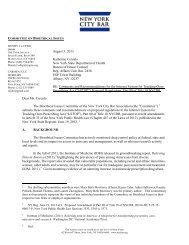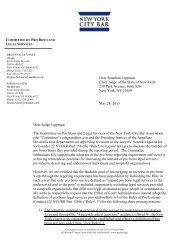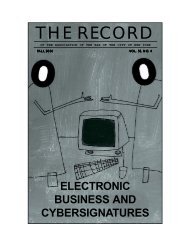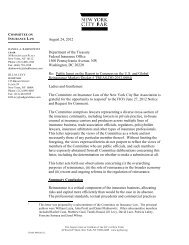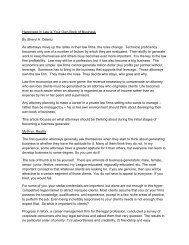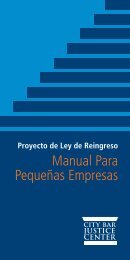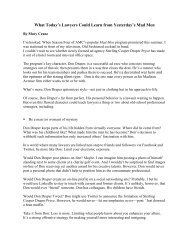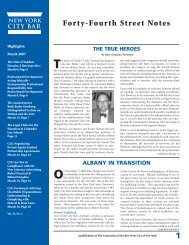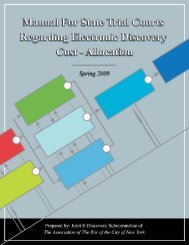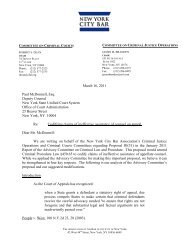2007 Issue 1 - New York City Bar Association
2007 Issue 1 - New York City Bar Association
2007 Issue 1 - New York City Bar Association
Create successful ePaper yourself
Turn your PDF publications into a flip-book with our unique Google optimized e-Paper software.
J U D I C I A L S E L E C T I O N S Y S T E M I N N E W Y O R K S T A T E<br />
the qualifications of judicial candidates for office and are not well suited<br />
to evaluate the significance of those qualifications (or the lack of them). 27<br />
Although the Office of Court Administration has adopted regulations<br />
designed to inform voters whether an “Independent Judicial Election<br />
Qualification Commission” (“Qualification Commissions”) in each Judicial<br />
District has found a candidate “qualified for judicial office,” 28 these<br />
Qualification Commissions are wholly inadequate to educate voters about<br />
the “qualified” candidates. Nor may the Qualification Commissions indicate<br />
whether an applicant has been found unqualified for judicial office.<br />
29 Nor is there any limitation on the number of candidates each Qualification<br />
Commission may report out as “qualified.” Voter guides offer a<br />
modest potential for improvement in this regard; but the reality remains<br />
that the vast majority of potential voters lacks the information, background<br />
and experience necessary to identify the most qualified candidates<br />
for office.<br />
In other settings, this <strong>Association</strong> 30 and other organizations 31 have<br />
set forth the position that independent screening commissions should<br />
determine whether candidates are “qualified,” should identify any candidates<br />
found unqualified and should impose strict limits (typically three<br />
for the first vacancy) on the number of candidates reported out as “qualified.”<br />
In Section II of this Report, we flesh out the details of this proposal<br />
and reiterate its importance as an adjunct to other changes necessary to<br />
comply with the mandate in Lopez Torres. However, even if these changes<br />
27. See, e.g., London, supra note 24 (noting that the Chief Justice of Washington State, “a<br />
widely respected judge who has drawn little controversy in his six years in the post, was<br />
thrown off the bench last week by voters who chose instead a 39-year-old lawyer who has<br />
never been an elected judge and who did not campaign.”).<br />
28. Each Qualification Commission is charged with evaluating whether candidates for election<br />
to the Supreme Court, County Court, Surrogate’s Court, Family Court, <strong>New</strong> <strong>York</strong> <strong>City</strong><br />
Civil Court, District Courts and <strong>City</strong> Courts are “qualified for judicial office,” and with<br />
publishing an alphabetical list of the names of all candidates it has found “qualified.” N.Y.<br />
Comp. Codes R. & Regs. tit. 22, § 150.5 (2006). No candidate is required to submit credentials<br />
to the Qualification Commission, however.<br />
29. Except as to any report whether a candidate is “qualified”, “all papers filed with or<br />
generated by the commission and all proceedings of the commission shall be confidential.”<br />
N.Y. Comp. Codes R. & Regs. tit. 22, § 150.8. Thus, the public could not ascertain whether<br />
a candidate applied for evaluation or whether, upon applying, the candidate was found<br />
unqualified.<br />
30. See Task Force 2003 Report at 30-37.<br />
31. See, e.g., The Fund for Modern Courts, 2003 Policy Statement, available at http://<br />
www.moderncourts.org/Advocacy/judicial_selection/policy.html.<br />
2 0 0 7 V O L. 6 2 , N O. 1<br />
101



